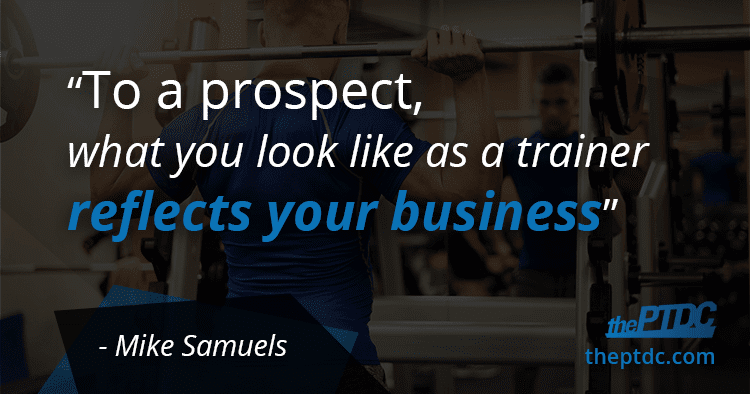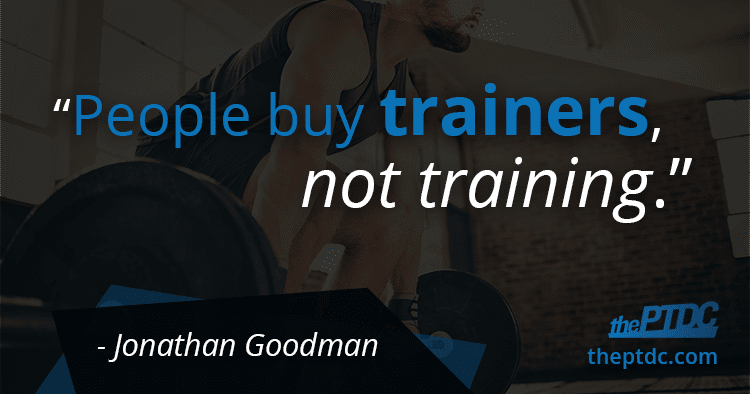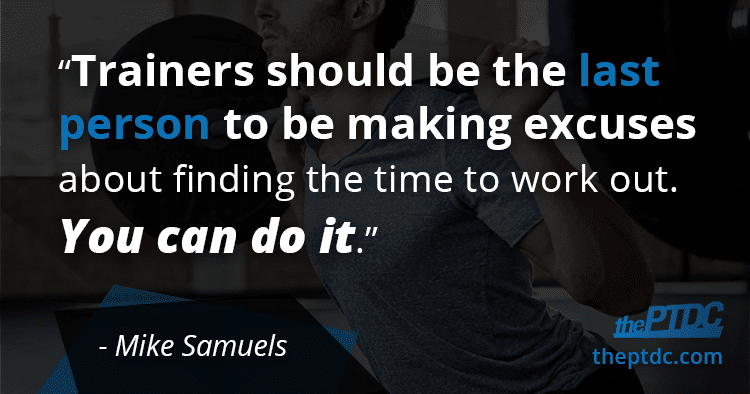Jonathan Goodman often says this:
“People buy trainers, not training.”
You’ll be hired because of your reputation, your perception of expertise, and how you look. It comes with the territory.
But here's the challenge: The more successful you are, the busier you'll be. And the busier you become, the harder it'll be to squeeze in your own workouts.
Sometimes it seems like your job conspires against the reason you have the job. Long hours on your feet and an erratic client schedule leave you so drained that the last thing you want to do is to spend more time at the gym.
The problem, of course, is that personal training is one of the few industries where you're judged on your looks. If you don't look like you follow your own advice, why would a prospect choose you over a trainer who's in better shape?
It’s not shallow. It’s just business. Your business.
It's much easier to stay in shape than it was to get in shape in the first place. You just need to make it a priority.
The following workouts take less than 30 minutes, and they’re easy to bust out between client sessions.
5 ways to make working out easier
1. Don't train like an Olympian
Don’t try to perform a professional athlete-style workout at 10 o'clock on a Monday night when you’ve been up since 6 a.m. Unlike Olympians, you’re not just training, eating, and sleeping. You’ve got a lot of other obligations (like your clients!) to consider.
Plan your longest and most brutal workout sessions on days when you have the fewest clients and the least work. You'll have both physical and mental energy. If you absolutely have to train after such a long day, make it something short and self-indulgent, like a bro-style arm workout.
2. Have an “I’m training” face and a “Can I help you?” face
When you’re doing your own workout in the gym where you work, people will come up to you and ask questions. If you're polite and accommodating, you'll compromise your training. But if you ignore them, you'll compromise your business.
That's why you literally need two faces.
While you’re training, put on a game face, one that lets gym members know you're focused on the task. Make sure you're dressed for training, and put on headphones that give you an excuse not to hear random questions or comments. If someone insists on talking to you anyway, make a show of pausing your music, removing your earbuds, and saying, politely but firmly, "Can I help you after I finish my workout?"
Give yourself a little time to make the transition from training mode to service mode. Take a quick shower and change into your professional attire. When you step back onto the gym floor, make eye contact, smile, and show you're happy to help anyone who needs you.
Once you master the two faces, you'll be respected as a trainer who trains hard but is also compassionate and helpful.

But if you struggle to pull it off, you may find it's better to train somewhere else. For example, a trainer I know owns his own studio. Because it's bad for business to turn his back on clients and customers, he does his heaviest and most intense workouts at a gym five minutes down the road. People there probably know he's a trainer, but because he's not their trainer, they don't feel entitled to interrupt him while he's training.
3. Never train with your clients
Just don’t, my friend.
Doing so can blur the professional relationship, and it devalues their sessions with you. If a client is paying you for your time, your focus should be entirely on them. You need to be correcting form, counting reps, and offering encouragement, not worrying about your own technique, or figuring out whether you matched last week’s reps.
When your client is training, focus on them. When you’re training, focus on you.
4. Be flexible
You should schedule your own workouts in a calendar, just as you schedule your clients' sessions. But we all know a trainer's calendar never goes 100 percent according to plan. So you have to be prepared for the unexpected.

Some days you'll have to give your own workout slot to a paying client. Sometimes you'll have to swap your Smolov squat workout for a 20-minute leg blast.
Like everything else in life, you need to find a balance. What you give up in short-term gains you'll more than make up for in long-term client loyalty.
Just don't do it too often, or too willingly. In a profession where appearance matters, you're the most important client on your schedule.
5. Quit hitting the pause button on your life
If you’re telling yourself you’ll get back in shape when you have more time, you have what John Berardi of Precision Nutrition calls the “pause button mentality.”
It’s the idea that you can “pause” your plans—whether it's a workout program or diet—and have a fresh start another day. It’s like the New Year's Resolution dieters who tell themselves, “I’ll have these donuts now and start over on Monday.” Knowing you can “start over” offers a reprieve, and a sense of relief.

But as Berardi points out, “The pause-button mentality only builds the skill of pausing.”
Life has no pause button. Time still passes. Bills still need to be paid. Clients still need to be trained. And your body still needs your time and attention. There won't be a better time than now.
This snippet from Berardi’s post should wake you up:
That’s why, when our clients ask to press pause, we usually ask them:
“What will be different when you come back?”
Nine times out of 10, the honest answer is nothing. Nothing will be different.
Life is just … happening. And it’ll happen again in January, or after the baby is born, or after Mom gets better, or at any other arbitrary point you pick.
You should be the last person to make excuses about finding the time or energy to work out. Why should your clients trust the advice you give them if you can't make it work for you?
Your workouts don't have to be long, intense, or extremely results-oriented. They just need to help you maintain what you have. Your business depends on it.











